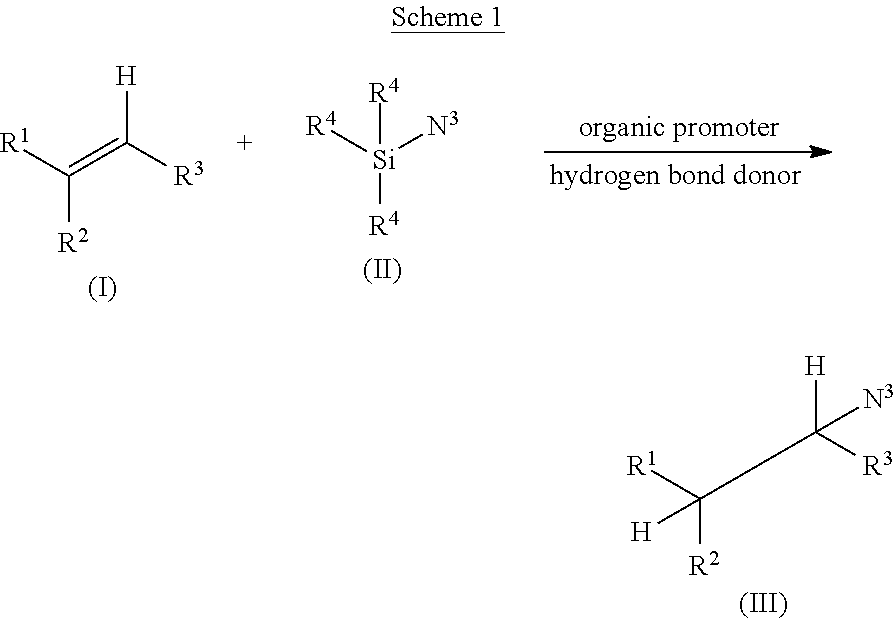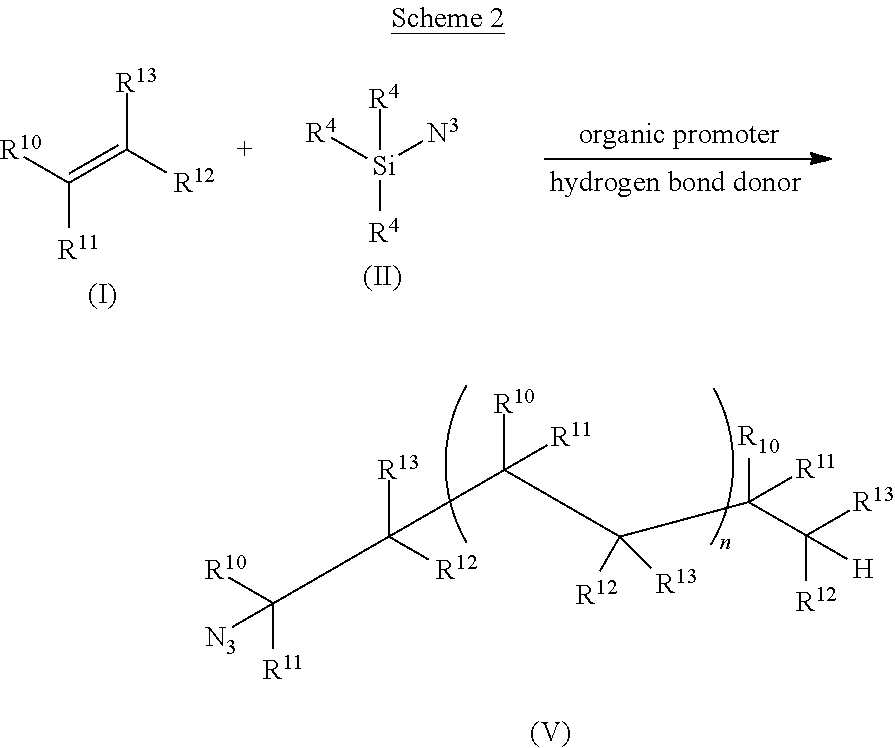Environmentally-friendly hydroazidation of olefins
a technology of olefins and hydroazidations, applied in the field of organic azidation synthesis processes, can solve the problems of significant additional purification steps
- Summary
- Abstract
- Description
- Claims
- Application Information
AI Technical Summary
Benefits of technology
Problems solved by technology
Method used
Image
Examples
example 1
of 1-Azidododecane by Procedure 1
[0373]
[0374]1-Dodecene is commercially available and was distilled before use.
[0375]To a flame-dried sealable 2-dram vial equipped with a stir bar were added 1-dodecene (222 μL, 1.0 mmol, 1.0 equiv) and 1-hydroxy-1λ3-benzo[d][1,2]iodaoxol-3(1H)-one (27 mg, 0.1 mmol, 0.1 equiv). After this vial was evacuated and backfilled with N2 twice, anhydrous CH2Cl2 (0.2 mL) and H2O (18 μL, 1.0 mmol, 1.0 equiv) were added via syringes. Freshly opened trimethylsilylazide (237 μL, 1.8 mmol, 1.8 equiv) was added to the reaction and the mixture was stirred for 2 h at 22° C. until the olefin was fully consumed (monitored by TLC). The reaction was cooled to 0° C., Hexanes (2 mL) and saturated NaHCO3 solution (1.5 mL) were added to quench the reaction and to neutralize the residual hydrazoic acid. The organic phase was separated from the aqueous phase, and the aqueous phase was extracted with hexanes (3 mL×3). The combined organic phase was washed with brine (2 mL) and ...
example 2
of 1-Azidododecane by Procedure 2
[0376]
[0377]To a flame-dried sealable 2-dram vial equipped with a stir bar were added 1-dodecene (222 μL, 1.0 mmol, 1.0 equiv) and 1-hydroxy-1λ3-benzo[d][1,2]iodaoxol-3(1H)-one (19 mg, 0.07 mmol, 0.07 equiv). After this vial was evacuated and backfilled with N2 twice, anhydrous CH2Cl2 (0.2 mL) and H2O (11 μL, 0.6 mmol, 0.6 equiv) were added via syringes. After the vial was cooled to 0° C., freshly distilled trimethylsilylazide (237 μL, 1.8 mmol, 1.8 equiv) was added to the reaction followed by the addition of trifluoroacetic acid (TFA) (15 μL, 0.2 mmol, 0.2 equiv). The mixture was warmed up to 22° C. and kept stirring for 1.5 h until the olefin was fully consumed (monitored by TLC). The reaction was cooled to 0° C., hexanes (2 mL) and saturated NaHCO3 solution (1.5 mL) were added to quench the reaction and to neutralize the residual hydrazoic acid. The organic phase was separated from the aqueous phase, and the aqueous phase was extracted with hexane...
example 3
of 1-Azidododecane by Procedure 3
[0378]
[0379]To a flame-dried sealable 2-dram vial equipped with a stir bar were added 1-dodecene (222 μL, 1.0 mmol, 1.0 equiv) and 1-hydroxy-1λ3-benzo[d][1,2]iodaoxol-3(1H)-one (19 mg, 0.07 mmol, 0.07 equiv). After this vial was evacuated and backfilled with N2 twice, anhydrous CH2Cl2 (0.2 mL) and trifluoroacetic acid (15 μL, 0.2 mmol, 0.2 equiv) were added via syringes and the mixture was stirred at room temperature for 5 min. During this time, the solution first became homogenous, and then white precipitates formed. H2O (11 μL, 0.6 mmol, 0.6 equiv) and trimethylsilylazide (239 μL, 1.8 mmol, 1.8 equiv) were added to the reaction and the mixture was stirred at room temperature for 1.5 h until the olefin was fully consumed (monitored by TLC). The reaction was cooled to 0° C. Hexanes (2 mL) and saturated NaHCO3 solution (1.5 mL) were added to quench the reaction and to neutralize the residual hydrazoic acid. The organic phase was separated from the aqu...
PUM
| Property | Measurement | Unit |
|---|---|---|
| mol % | aaaaa | aaaaa |
| mol % | aaaaa | aaaaa |
| mol % | aaaaa | aaaaa |
Abstract
Description
Claims
Application Information
 Login to View More
Login to View More - R&D
- Intellectual Property
- Life Sciences
- Materials
- Tech Scout
- Unparalleled Data Quality
- Higher Quality Content
- 60% Fewer Hallucinations
Browse by: Latest US Patents, China's latest patents, Technical Efficacy Thesaurus, Application Domain, Technology Topic, Popular Technical Reports.
© 2025 PatSnap. All rights reserved.Legal|Privacy policy|Modern Slavery Act Transparency Statement|Sitemap|About US| Contact US: help@patsnap.com



